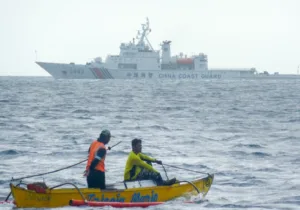Three-quarters of a century ago, in the opening days of the Second World War in the Pacific, a joint U.S. and Filipino (Filamerican) army fought desperately to defend Manila Bay and the Philippines against a Japanese invasion. Much of the campaign (8 December 1941–6 May 1942) was waged on both the Bataan Peninsula and Corregidor Island in the mouth of Manila Bay. Despite dwindling supplies and dim prospects for outside help, the garrison held on as long as possible and seriously delayed the Japanese timetable for conquest in the Pacific. In the end, the Japanese succeeded in forcing the largest capitulation in U.S. military history.
The 1941–1942 Philippine Campaign was fought between the Japanese 14th Army, commanded by Lieutenant General Masaharu Homma, and General Douglas MacArthur’s U.S. Army Forces in the Far East (USAFFE). The Japanese were confident of victory, and gave Homma just 50 days to capture the Philippines before his troops would be transferred elsewhere; only the British bastion at Singapore was expected to hold out longer. Japanese planners expected that MacArthur would make his stand around Manila, the Philippine capital, and once that battle was won the rest of the islands could be occupied at leisure.
The campaign began on 8 December 1941 (7 December, Washington time) with air strikes on key air bases on the main island of Luzon, which succeeded in wiping out much of MacArthur’s air force and removing one of the key pillars of the Filamerican defense strategy. Small Japanese landings on the north of Luzon followed, but failed to stir a strong Filamerican reaction.
MacArthur’s command was divided in two: the North Luzon Force under Major General Jonathan M. Wainwright, and the South Luzon Force under Major General George M. Parker. On 22 December 1941, the 14th Army’s main body landed at Lingayen Gulf; two days later another force landed on the Bicol Peninsula in southeastern Luzon. MacArthur planned to defend the beaches and throw the invaders back into the sea, but Wainwright’s counterattacks on the 22nd and 23rd failed due to poor reconnaissance, poor coordination, and poor logistics. Many Filipino units were untrained or half-trained at the war’s start, and broke at first contact with the enemy.
In Manila, MacArthur digested the reports from Lingayen Gulf. He realized the landing represented the main Japanese effort with Manila as its objective. MacArthur also faced the hard truth that his plan to defend the beaches had failed within the first 24 hours of the main invasion. Prewar planners had prepared a scheme for withdrawing to the Bataan Peninsula and Corregidor Island (on the western end of Manila Bay), and on Christmas Eve MacArthur ordered the plan, known as WPO-3, put into effect.
WPO-3’s activation meant that all of USAFFE’s 80,000 men had to move from all over Luzon to Bataan. Writing after the war, MacArthur’s staff summed up the challenges:
The difficult problem [MacArthur] faced was to sideslip his troops westward in a series of rapid maneuvers and holding actions to the rocky peninsula and to the island forts in Manila Bay before superior forces of the enemy could cut off their path from the north. The crux of the problem was the successful passage of a famous tactical defile-the bridge at Calumpit, just south of San Fernando in Pampanga, where Highway No. 3 from northern Luzon to Manila joined with Highway No. 7 leading into Bataan. The movement of the Southern Luzon Force, already complicated through the passage of Manila, was inevitably canalized at Calumpit, and once across the bridge, this force would also have to pass through San Fernando before it was safely on the road to Bataan.
As a corollary, the hard-pressed Northern Luzon Force would have to hold the enemy back from San Fernando and the Calumpit bridge no matter what the price until the Southern Luzon Force had cleared the critical defile, or General MacArthur stood to lose nearly half the forces with which he expected to defend Bataan and Corregidor. On top of these risks, the Japanese held air supremacy over the battlefield; the WPO-3 movements would be detected and attacked.
WPO-3’s evacuation shocked Manila. Many Filipinos assumed there would be a battle for the capital, and fear swept through Manila’s diverse population. On Christmas Eve Philippine President Manuel Quezon, his family, and elements of the cabinet left for Corregidor. Late in the day MacArthur sailed to Corregidor with his senior staff and family, who had evacuated their residence in the Manila Hotel that afternoon on four hours’ notice. On Boxing Day the Philippine capital was declared an open city.
In a series of hard-fought battles, Wainwright’s North Luzon Force held successive defense positions long enough for the South Luzon Force to race northward and westward around Manila Bay. Men and supplies also moved into Bataan despite Japanese air attacks; Homma’s staff underestimated the significance of the Filamerican withdrawal and stayed focused on Manila. On the morning of New Year’s Day 1942, the Calumpit Bridge was destroyed. Homma’s forces entered Manila on 2 January; from Corregidor Americans watched through binoculars as Japanese flags went up over the Manila Hotel and other places along the waterfront.
By 7 January the USAFFE forces stood ready on Bataan to repel any further Japanese advances. However, in the hasty withdrawal not enough food made it to the peninsula in time; the Bataan garrison immediately went on half rations.
MacArthur’s line stretched across the peninsula’s base from Abucay to Mauban, with a break around rugged Mount Natib. Wainwright’s force, renamed I Corps, held the western sector while Parker’s command (now known as II Corps) took over the eastern half. The Japanese repeatedly attacked the Abucay position head on, but failed to break through. Assaults west of Abucay bent Parker’s line with fierce fighting. Flanking operations over Mt. Natib finally succeeded reaching the USAFFE rear, in one place cutting the main road behind I Corps. On 22 January MacArthur ordered a retreat to a new position halfway down the peninsula, running from Orion to Bagac. Four days later his forces were in position and reorganizing for their last stand on Bataan.
Flushed with victory, Homma’s men closed with this new line and attacked immediately. Most of the assaults were repulsed after several days of intense fighting, but a deep penetration in Wainwright’s line (later known as the Pockets) took three weeks to wipe out. Homma also sent several battalions of infantry to land on the west coast of Bataan and smash supplies and rear-area installations. These landings (named the Points) were contained by a scratch force of Philippine Scouts, pilots converted to infantry, and other rear-area troops. Reserve infantry and tanks came forward and crushed the Points and Pockets over two weeks of bitter fighting that ended in mid-February.
The defeat of the Points and the Pockets attacks represented the first time Allied forces had stopped a major Japanese land offensive in the Pacific War. More importantly for MacArthur, the victory ensured the continued survival of his forces for the time being. Homma pulled back his mangled units to regroup and await reinforcements. Judging his forces too weak to counterattack, MacArthur ordered them to dig in and await the next Japanese blow.
A lull settled over the Bataan battlefront. However, the cumulative effects of poor rations now became more apparent. Daily rations of 2,000 calories had “dropped to 20 ounces (1,500 calories) in February and to 15 ounces (1,000 calories) in March and April,” reported Brigadier General Charles Drake, MacArthur’s chief quartermaster. “The last consisted principally of rice varying from ten to fourteen ounces and a little meat, canned milk, and canned vegetables.” Insufficient food left the men listless, easily tired, and showing what one Filipino officer termed an “unacceptable indifference” to the battlefield situation.
Disease also took its toll. “Bataan is a malarial infested region,” wrote General Parker. “Lack of quinine had brought the hospitalization for malaria to 500 daily by 1 March and 1000 daily by 1 April. Due to lack of vitamins, beriberi was flagrant and increasing. Dysentery and diarrhea were extremely prevalent and due to the weakened condition of the men, it could not be controlled.” By 1 April the Bataan garrison’s 78,500 men were down to only 25% effectiveness.
Still, the defenders held together. Some clung to rumors of reinforcements: “There was not a day that you didn’t hear ships were on the way,” remembered Lieutenant Hattie Brantley, a U.S. Army nurse. “And we believed every word of every rumor. I think, now, it was part of the psychology of survival. If you had known that you were going to be a captive of the Japs for three and a half years, you wouldn’t have existed. You would have given up right then.”
Lieutenant Henry Lee struck a deep chord with his widely-circulated poem, “Fighting On”:
I see no gleam of victory alluring,
No chance of splendid booty or of gain,
If I endure—I must go on enduring
And my reward for bearing pain—is pain;
Yet, though the thrill, the zest, the hope are gone,
Something within me keeps me fighting on!
Bataan’s defenders defiantly referred to themselves as “The Battling Bastards of Bataan.”
Events elsewhere affected the Philippine defenders’ fortunes. Bataan was the only place where the Japanese march of conquest had been stopped; elsewhere in Southeast Asia the Allies met defeat after defeat throughout February and early March. As the Philippines became more isolated, it became clear that the defenders were doomed. In February submarines evacuated part of the Philippine treasury, President Quezon and his family, and High Commissioner Francis Sayre and his family.
Radio Tokyo had announced that MacArthur would be hung in Tokyo as a war criminal; in the United States, political pressure built upon President Franklin Roosevelt to save MacArthur. But MacArthur was determined not to leave, telling Washington on 11 February that he, his wife Jean, and their 4-year-old son Arthur would “share the fate of the garrison.” What tipped the balance was a request from Australia for a senior U.S. general to take command of the Southwest Pacific region.
On 23 February MacArthur received a telegram from Washington. He read: “The President directs that you make arrangements to leave Fort Mills [Corregidor] and proceed to Mindanao. You are directed to make this change as quickly as possible. The President desires that in Mindanao you take such measures as will ensure a prolonged defense of that region… From Mindanao you will proceed to Australia where you will assume command of all United States troops.”
A stunned MacArthur tried to duck the order, even to the point of resigning his commission. His staff talked him out of that, and MacArthur prepared for departure. On 11 March he, his family, and select staff departed Corregidor via PT boats and arrived on the north shore of Mindanao on the morning of 13 March. Three days later they flew on B-17s overnight to Australia, landing on the morning of 17 March. Shortly after his arrival, General MacArthur announced to the press, “I came through, and I shall return.”
General Wainwright received a third star and overall command of the Philippine defenders, renamed U.S. Forces in the Philippines, or USFIP. Major General Edward P. King assumed command of the Bataan garrison, renamed Luzon Force, and Major General Albert Jones took over I Corps.
Homma meanwhile received heavy reinforcements and planned a new offensive. The final Japanese blow fell on Good Friday, 3 April 1942, and it fell squarely on the II Corps line. The Filamerican forces gave ground, and King committed his reserves to counterattack and stabilize the situation. Despite these efforts, the Japanese continued to slash their way southward. By the evening of 6 April, the Luzon Force’s line was irreparably broken; Japanese units raced down the east coast of Bataan. Troops gathered for a last stand, but everyone sensed the end was near. To save his men from massacre, General King surrendered the Luzon Force on 9 April, in the largest capitulation in U.S. history.
In Australia, General MacArthur issued a statement. “The Bataan force went out as it would have wished, fighting to the end of its flickering, forlorn hope,” he said. “No army has ever done so much with so little and nothing became it more than its last hour of trial and agony. To the weeping mothers of its dead, I can only say that the sacrifice and halo of Jesus of Nazareth has descended upon their sons, and that God will take them unto Himself.”
General King surrendered 76,000 American and Filipino soldiers on 9 April 1942. Approximately 1,500 of that total were transferred or escaped to Corregidor, which meant that about 74,000 men were going with him into captivity—far more than the 40,000 prisoners the Japanese expected to house and feed. The result was one of the Pacific War’s worst atrocities.
Over the next three days, King’s troops began their trip out of Bataan to a prison camp at Camp O’Donnell near Clark Field. Except for a short train trip from San Fernando Pampanga to Capas, the 66-mile journey was by road. Some rode in Japanese trucks, but the majority of prisoners, including several senior commanders, walked. Japanese treatment of the Bataan defenders was often cruel, capricious, and in some cases murderous. Only 54,000 arrived at Camp O’Donnell, which meant that over two weeks, 20,000 Americans and Filipinos disappeared between Bataan and O’Donnell. Five thousand stayed behind in the hospitals and on work details, while an undetermined number escaped to fight as guerrillas. The vast majority (usually estimated at 11,000) died on the road. Of those deaths, at least 650 were Americans. Ever after, this trip to prison would be known as the Bataan Death March.
The Japanese next turned their attention to Corregidor. After nearly a month of incessant air and artillery bombardment, they invaded and captured the island on 6 May 1942. The fall of Corregidor precipitated the surrender of the entire Philippines, and the Japanese finally held the islands after more than five months of hard fighting.
The fall of the Philippines ranks as one of the worst defeats in U.S. military history, and King’s capitulation on 9 April is far and away the largest of its kind in American history. But the valiant defense of the Philippines was not in vain; the USAFFE/USFIP troops had held out for five months, disrupted the Japanese timetable of conquest, and denied the enemy use of the key base at Manila Bay. Their stand inspired the Allied world, and would do so until the final victory over the Axis in 1945. Most importantly, through their victories in early February the Bataan defenders had shown that the Japanese could be beaten. Lessons and intelligence about weapons and tactics, both American and Japanese, learned during the campaign would influence U.S. training, equipment, and preparations for battle in future Pacific operations.
Today, the defense of Bataan occupies a central place in Philippine national identity. Monuments mark key locations on the battlefield, and the 9th of April is a national holiday. The Camp O’Donnell site is now the Capas National Shrine. One of the monuments there honors the men held there in the summer of 1942. At the top is a quote from General King: “Courage is a quality God has seen fit to dispense with utmost care. The men of Bataan were His chosen favorites.” There is no better tribute.
—
Christopher L. Kolakowski works as a historian in Norfolk, Virginia. He is the author of four books on the American Civil War and World War II, including Last Stand on Bataan, and is working on a study of the 1944 India-Burma campaigns. The views contained herein are his own.
Photo Credit: Manila Burns after an Air Raid, December 1941. Source: MacArthur Memorial Archives.





